| Rye %: | 100% |
| Stages: | Sponge, Final dough |
| Leaven: | Sour culture |
| Start to Finish: | 24-30 hours |
| Hands-on Time: | 30 minutes |
| Yield: | One 4 lb./1.80 kg loaf |
Over the months and years I’ve spent baking rye breads, I’ve developed a special fondness for Baltic ryes and for coarse-textured rustic breads. This Coarse Rye from Latvia fills the bill on both, making it one of my favorites. Interestingly, it combines bulk ferment, soaking and proofing into a single 12 to 16-hour stretch, after which the dough gets benched and baked in quick succession.
Like most Baltic ryes, it’s big – about 4 pounds/1.80 kg – and intensely flavored. A clear sour is its most pronounced flavor note, followed by the sweet spiciness of the rye, with barely a hint of caraway to add an astringent edge. As one would expect from a bread made up almost entirely of coarse and medium rye meal, the crumb is dense and coarse, offering a chewy, texturally engaging bite.
This is a bread that stands up well to strong flavors — charcuterie, for example, or savory soups and stews. I like it for breakfast or lunch slathered generously with liverwurst and a dab of Dijon mustard.
Sponge (Day 1, Evening):
| Ingredient | Grams | Ounces | Baker’s Percentage |
| Medium or whole rye flour | 95 | 3.35 | 100% |
| Warm (105°F/41°C) water | 95 | 3.35 | 100% |
| Rye sour culture | 10 | 0.35 | 11% |
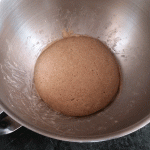 Combine the sponge ingredients, cover and ferment at room temp (70°F/21°C) 10-12 hours or overnight. The sponge will have doubled in volume and show broken bubbles on the surface.
Combine the sponge ingredients, cover and ferment at room temp (70°F/21°C) 10-12 hours or overnight. The sponge will have doubled in volume and show broken bubbles on the surface.
Final Dough (Day 2, Morning):
| Ingredient | Grams | Ounces |
| Sponge | 200 | 7.05 |
| Coarse rye meal | 700 | 24.70 |
| Medium rye meal | 300 | 10.60 |
| Warm (105°F/41°C) water | 1,000 | 35.25 |
| Salt | 12 | 0.40 |
| Dark brown sugar | 50 | 1.75 |
| Caraway seed | 10 | 0.35 |
Add the final dough ingredients to the sponge.
Use the paddle at lowest (KA1) speed to mix until fully blended into a very loose, batter-like dough, 7-8 minutes.
Cover and ferment at room temperature until the dough has visibly expanded and shows bubbles on the surface.
Turn the dough, which will have thickened considerably, onto a sheet pan lined with a lightly greased sheet of parchment paper.
Use wet hands and a scraper to shape the dough into an oblong loaf about 6 inches/15 cm wide and 14-16 inches/35-40 cm long.
Preheat the oven to 430°F/220°C with the baking surface in the middle and bake for 45 minutes, then reduce the temperature to 360°F/180°C and bake until the loaves thump when tapped with a finger and the internal temperature is at least 198°F/92°C, 40-45. Transfer to a rack and let stand 24-48 hours before slicing.
Baker’s Percentages:
| Ingredient | g | % |
| TOTAL FLOUR | 1,095 | 100.00% |
| Coarse rye meal | 700 | 63.93% |
| Medium rye meal | 300 | 27.40% |
| Whole rye flour | 95 | 8.68% |
| Water | 1,095 | 100.00% |
| Salt | 12 | 1.10% |
| Rye sour culture | 10 | 0.91% |
| Brown sugar | 50 | 4.57% |
| Caraway seed | 10 | 0.91% |
| TOTAL FORMULA | 2,272 | 207.49% |

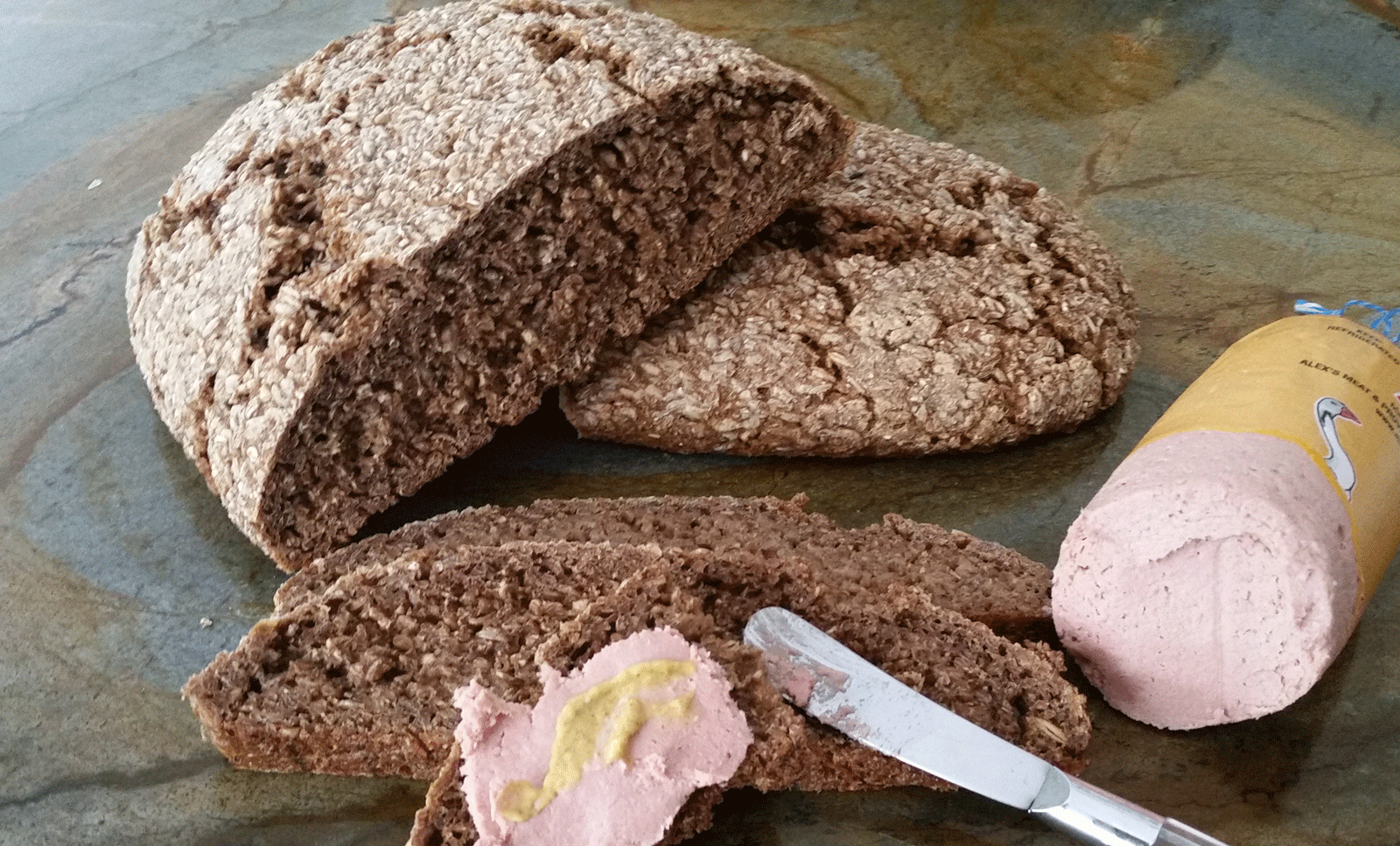
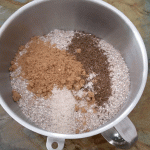
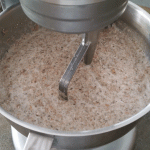
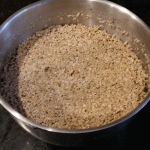
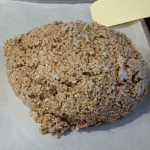
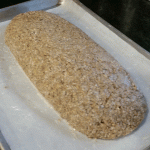
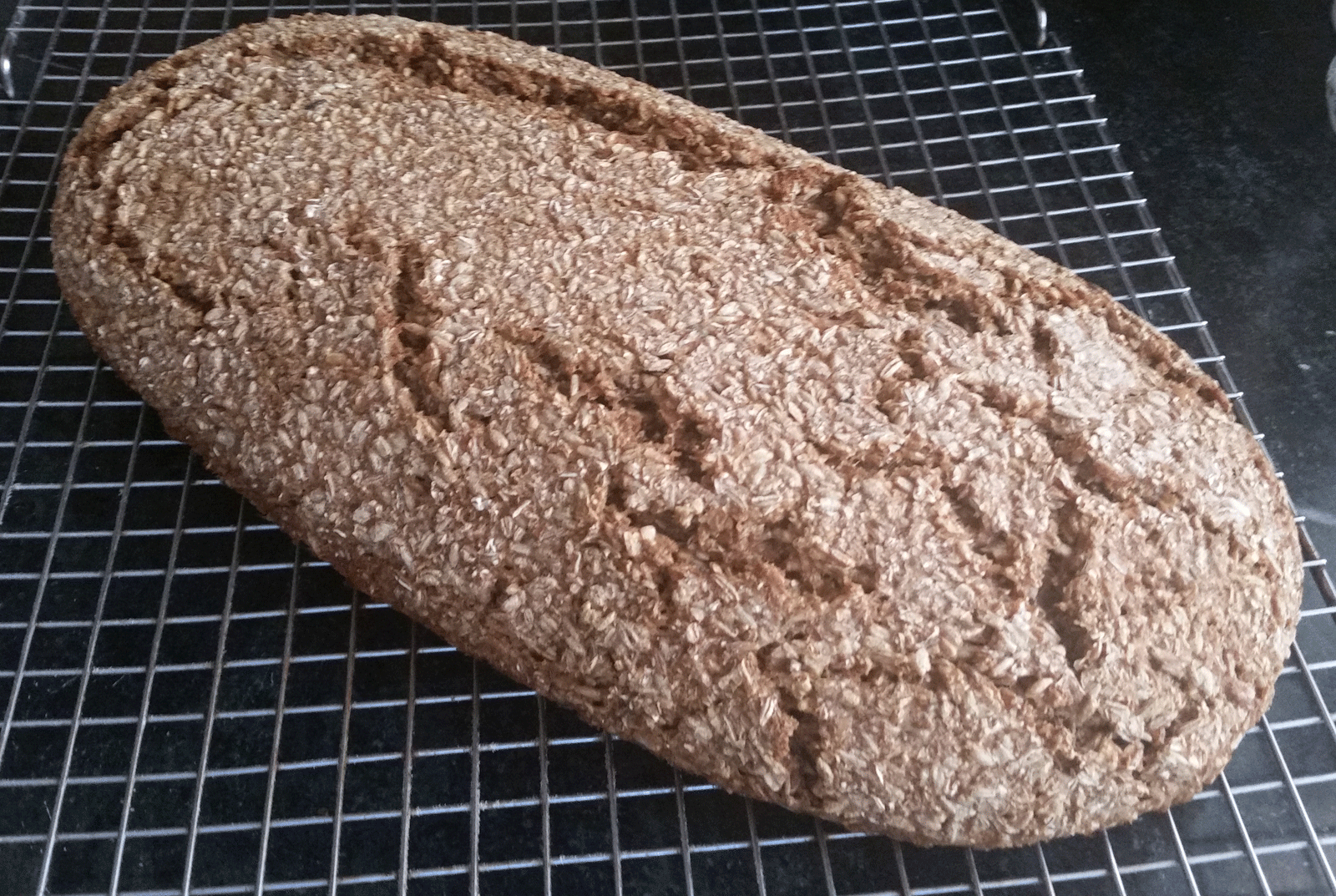
Mark Woodward
August 6, 2016I’m a little confused by the timing. Are suggesting that bulk fermentation should take place over night and baking the morning of day 2? Cheers, Mark
Stanley Ginsberg
August 6, 2016My error … Yes, the sponge should be left to ripen overnight and final dough/baking take place the morning of Day 2. Entry has been changed to reflect that. Thanks for the heads-up.
Mark Woodward
August 8, 2016Well, I let the sponge ferment for about 15 hours as it didn’t seem ready sooner. The dough itself fermented for about 3 hours. Yes, it was very wet and did thicken a bit. But I probably should have cut the water somewhat. I used freshly milled rye; perhaps it absorbs less water than your flour. Anyway, during baking the loaf spread to about 1.5″ tall and 9″ wide. I don’t think I’ll be making sandwiches with this loaf! It sure smells good though. I look forward to tasting it in two days.
Mark Woodward
August 12, 2016This is absolutely delicious!
Stanley Ginsberg
August 13, 2016Why I’m so fond of Latvian rye breads!
Latvian cook
March 12, 2017Hi Stanley! Love your cookbook! We are Latvians who love to bake rye bread (living in Canada) and have enjoyed making many of the recipes in your cookbook. So glad that you love the Latvian rye breads, but there are many other kinds of rye bread made in Latvia! Have you ever been to Latvia, to taste their freshly baked rye bread? It is heavenly! It has been said that the cobblestones in old Riga, when wet with rain, look like loaves of fresh rye bread, and I have to say, from first hand experience, that I can see why this analogy is drawn. There are many bakeries, and many of the rye breads are actually more similar to the rye breads of Sweden. Along that line, may I gently suggest that the Baltic rye breads be considered separately from the Russian rye breads. According to the United Nations, the Northern European countries are Denmark, Estonia, Finland, Iceland, Ireland, Latvia, Lithuania, Norway, Sweden and the United Kingdom. The Baltics and Russia are not very friendly with each other, given the history of the Soviet occupation in this region. Yes, foods sometimes cross boundaries, political or otherwise, but there are so many other Latvian rye breads that are quite different from the Russian style ones. For example, your Gotland Rye recipe is very similar to other Latvian rye bread recipes. If you are interested in learning more about Latvian rye breads, I would be happy to share recipes, and how it is enjoyed. If your travels take you to Latvia, I could connect you with local rye bread bakers as well. Thank you so much for elevating my beloved rye bread!
Stanley Ginsberg
March 18, 2017I understand that there’s no love lost between the Baltics and Russia. At the same time, a lot of the rye baking techniques and ingredients are very similar, for example use of scalded rye malt and caraway, and the combinations of scalds and sponges. However, it’s also true that while Russian breads are generally sour, the Baltic breads I’ve tasted have sweeter notes and are generally more complex than either Russian, Swedish or most Finnish breads.
I’d love to see your recipes. Baltic rye breads, especially Latvian breads, are a particular interest of mine.
Eva Smith
May 8, 2018I think the comments here were about bread and to put poltical commentary here about Russian “occupation” in Latvia is entirely misleading. I don’t recall the Latvians begging them to leave?
Anyway back to sour dough … i would recommend cutting the water down a little on the recipe and definately leaving at least 15hrs possibly longer
Loretta
August 15, 2016Do I let the shaped dough rise at all or do I put it in the oven right after shaping? Thanks.
Stanley Ginsberg
August 15, 2016hi Loretta,
This one goes into the oven right after benching, with no proof at all.
Mark
September 21, 2016Well, now I’ve made this three times. I reported on the first time above. The second time I decided to cut the hydration by 20%. The result was very easy to shape but I ended up with a very dense loaf and, while good, I don’t think the flavor was as good as the first time. The third time I cut the hydration by only 10%. The resulting loaf was reasonably shapeable and tastes delicious, but it spread a bit more than I would have preferred. Next time I think I’ll try cutting the hydration by 12%. Note that I’m using freshly milled rye, which seems to absorb less water than many of the flours out there.
Latvian cook
March 13, 2017Many Latvian bakers just put their traditional rye bread dough into bread pans – and it works well in that shape as well as in the free form version. Easier to cut it for sandwiches too!
Sandra Tomsons
February 13, 2018In the future I hope to bake my own Latvian bread. However, at present I have been buying Latvian bread (and other amazing things) from the Baltic Shop. What I urgently need to know is how to cut the really huge loaf of bread that has been sitting on my counter for two weeks. The two men that tackled it on the weekend made a real mess. How does a pretty strong Nova Scotian woman cut this bread so that it looks as beautiful as when she buys the smaller loaf. Of course, it always tastes DELICIOUS. Could you send responses to: sandratomsons@gmail.com. I might never happen upon this wonderful site again. By the way Mark, are you using both course and regular freshly milled rye? This might be as important as the amount of water. (I just noticed the possibility of notification of new posts. Thanks!) Latvian Cook, are there Latvian bread makers in Antigonish County Nova Scotia?
Latvian cook
May 8, 2018In response to Eva Smith’s comments above, let’s just call Baltic bread Baltic bread, and call Russian bread Russian bread. There is a difference, and let us respect the differences.
Tracy Lynn
May 25, 2020hi there,
i am curious about the 24-48 hour rest time before slicing. i have to say waiting that long for a finished bake is a test of patience!
Stanley Ginsberg
June 23, 2020I agree, but then all of rye baking is a test of patience — much more so than baking with wheat. The logic behind the wait is that rye loaves, which tend to be far denser than wheat breads, need more time for the crumb to stabilize and the moisture and flavor elements to distribute evenly throughout the loaf. On the plus side, rye doesn’t go stale in the same way wheat breads do. A wait of two days would turn a baguette into a giant crouton; I’ve kept my rye breads on the counter for a week without significant deterioration.
tanyag7
July 14, 2020hi, I am new to this site. I grew up in Riga and I remember the bread we used to buy at our Farmers’ Market (centraltirgus), It could be bought by slice. We were poor and a slice of 200 grams was all about all we could afford at a time. But that small slice made our whole tiny apartment smell so heavenly. I returned to Riga in 1997 and went to the Centraltirgus and there were no breads baked by saimnieces/private owners, only the mass producers and that bread was not anywhere close to the breads I remember. I bought your book in hopes to find something close to what it used to be. And I am experimenting. Borodinsky came out pretty close to what I remember. There are one things I am not sure about – for a person who does not bake weekly, how often do I have to feed sour culture to keep it alive? I have it bubbly in the fridge but not sure what I am dealing with and would prefer not to destroy it too quickly. Thank you
Stanley Ginsberg
July 14, 2020Riga … I love Riga and hoped to return this year, but the pandemic is keeping me from it. Yes, Centraltirgus has become very antiseptic and aimed toward large producers, but it’s still so much better than almost anything we have in the US. In Latvia, even the large producers are small by US standards. It’s also true, as you noted, that no small bakeries selling there. In fact, last year I think only Laci was there. I don’t know what it was like when you went back in 1997, but today there are many, many people at tables outside the four main halls selling all sorts of wonderful seasonal goods like honey, wild mushrooms and berries in autumn.
For bread from small producers, I’d go to the ,Kalnciema Street Saturday market (Kalnciematirgus). There are several small craft bakers there, who make some really interesting bread, including one old lady who makes and sells sklandrausi. The market also has a dozen or so small cheese makers, butchers and people who pickle fish and vegetables. If you do get back there, you’ll find a very changed city, with lots of construction and especially restoration of the Jugenstil district around Albertiela. Paldies!
tanyag7
July 26, 2020Sounds wonderful. I am going thru Baltic recipes, Very slowly though. My sour culture has been refrigerated for 2 weeks now. How long am I able to keep it without feeding so I do not kill it? thank you for doing this. I have been looking for good Latvian bread recipes for 40 years now and this is the first time I am successful.
Alistair
February 13, 2021Hi Stanley, I have your book and it has been superb. I recently made the Riga Rye from it, which was excellent, and I love the breads with a coarse texture so I’m very excited about this one. Pardon my inexperience here but I have a question about the timing: the description says bulk ferment/proofing is 12-16 hrs, is the final dough really left for that long and if so will it only have “visibly expanded and shows bubbles on the surface” after such an extended period?